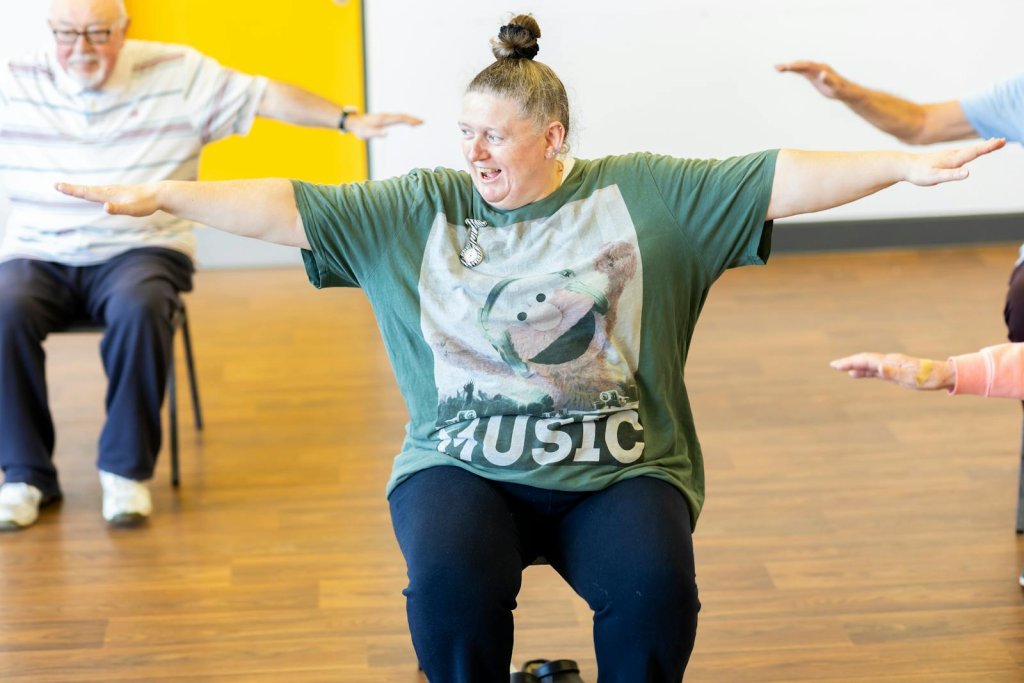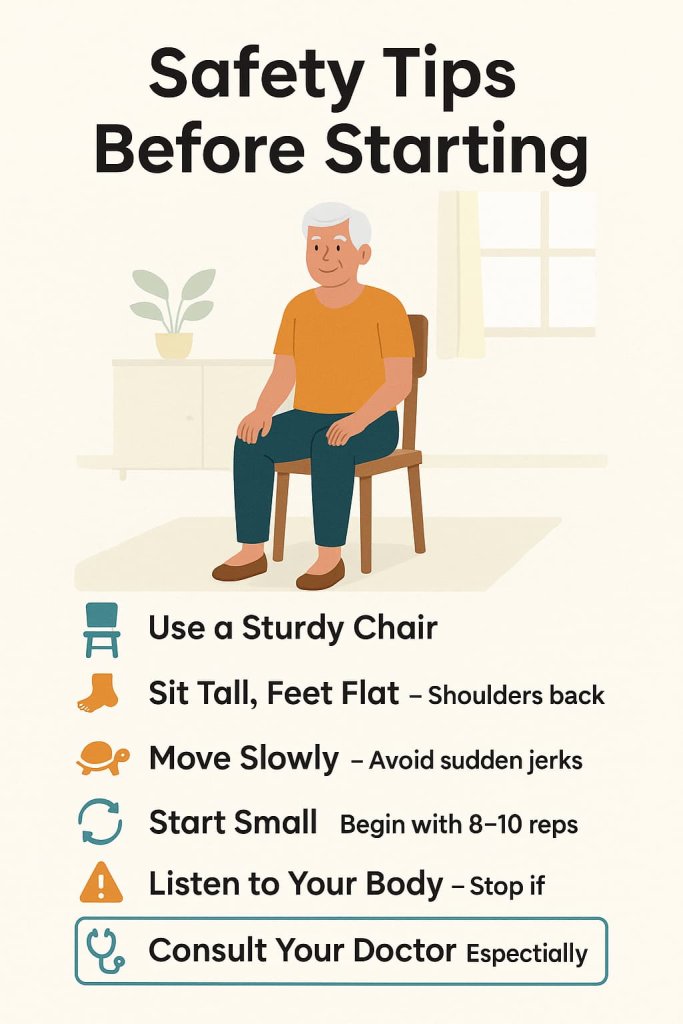Yes, seniors can safely improve strength, balance, and mobility with simple chair exercises.

Chair exercises for seniors are safe, effective, and easy to do at home. They reduce fall risk, support independence, and strengthen key muscles without needing gym equipment. Using a sturdy chair, you can train your legs, core, arms, and balance in short daily sessions.
According to the NHS, seated routines are an effective way to improve posture, mobility, and coordination while also supporting strength and flexibility.
Why Chair Exercises Matter for Seniors

- Prevent Falls: Stronger legs, hips, and ankles improve balance.
- Protect Joints: Low-impact moves reduce strain on knees and back.
- Support Independence: Easier to stand, climb stairs, and carry groceries.
- Improve Circulation: Seated marches and stretches keep blood flowing.
- Boost Energy & Confidence: Safe, controlled movements build trust in mobility.
Safety Tips Before Starting

- Use a sturdy, non-wheeled chair with a backrest.
- Keep feet flat and sit tall, shoulders back.
- Move slowly, avoid sudden jerks.
- Start with 8–10 reps; progress gradually.
- Stop if you feel pain or dizziness.
- Consult your doctor if you have chronic conditions.
15 Best Chair Exercises for Seniors
Chair exercises are one of the safest and most effective ways for older adults to build strength, improve balance, and maintain independence. These moves can be done at home using a sturdy chair, making them accessible for beginners and seniors with limited mobility.
Here are 15 easy but powerful chair exercises for seniors with clear instructions and benefits.
1. Sit to Stand (Chair Squat)
How to do it:
- Sit tall on a sturdy chair with feet hip-width apart, flat on the floor.
- Cross arms over chest (or place hands on thighs if needed).
- Lean forward slightly, press through heels, and stand up slowly.
- Sit back down with control.
Benefits: Builds leg and hip strength, improves independence for daily tasks like standing up, climbing stairs, and using the toilet.
Progression: Try without using arms. Add a small cushion on the seat to lower the chair height for more challenge.
Safety Tip: Use a stable chair without wheels; place near a wall if extra support is needed.
2. Seated Marching
How to do it:
- Sit upright with shoulders relaxed and hands on thighs or armrests.
- Lift right knee toward chest, lower it, then lift the left knee.
- Continue alternating in a marching motion for 30–60 seconds.
Benefits: Strengthens hip flexors, engages core, and boosts blood circulation.
Tip: Lift knees higher for more intensity.
3. Seated Knee Extensions
How to do it:
- Sit tall with feet flat on the floor.
- Straighten one leg until it’s parallel to the floor. Hold for 2–3 seconds.
- Lower slowly and switch sides.
Benefits: Strengthens quadriceps, supports knee health, and improves walking stability.
Progression: Add ankle weights or hold longer at the top.
4. Seated Calf Raises
How to do it:
- Sit tall with feet flat on the ground.
- Lift heels off the floor, rising onto toes while seated.
- Hold for 1–2 seconds, then lower slowly.
Benefits: Strengthens calves, improves circulation, and enhances walking balance.
Progression: Place a light object (like a book) on thighs for resistance.
5. Heel & Toe Taps
How to do it:
- Sit upright, legs hip-width apart.
- Extend one foot forward and tap toes on the floor.
- Switch to tapping heels, then alternate rhythmically.
Benefits: Improves ankle mobility, coordination, and blood flow.
Tip: Perform for 20–30 taps per side.
6. Arm Raises
How to do it:
- Sit tall with arms at sides.
- Raise both arms overhead or to the sides at shoulder level.
- Lower slowly with control.
Benefits: Builds shoulder strength, mobility, and posture.
Progression: Use light dumbbells or water bottles for resistance.
7. Biceps Curls
How to do it:
- Sit tall with elbows tucked close to body.
- Hold light dumbbells or water bottles.
- Curl arms toward shoulders, then slowly lower.
Benefits: Strengthens arms for lifting, carrying, and other daily tasks.
Tip: Exhale while lifting, inhale while lowering.
8. Seated Chest Press
How to do it:
- Sit tall, arms bent at 90° at chest level.
- Push arms forward as if pressing against resistance.
- Return slowly to starting position.
Benefits: Strengthens chest, shoulders, and arms.
Progression: Use resistance bands or light weights for added challenge.
9. Seated Side Bends
How to do it:
- Sit tall with feet flat. Place right hand behind head, left hand reaching toward floor.
- Gently bend sideways toward the reaching hand.
- Return to upright and repeat on the other side.
Benefits: Strengthens obliques, improves flexibility, and supports core stability.
Tip: Move slowly—avoid leaning forward or twisting.
10. Seated Twists
How to do it:
- Sit tall with arms crossed over chest.
- Slowly rotate torso to the right as far as comfortable.
- Return to center, then twist left.
Benefits: Improves spinal mobility, core strength, and posture.
Safety Tip: Keep movements gentle—avoid jerky twists.
11. Ankle Circles
How to do it:
- Sit tall and lift one foot slightly off the floor.
- Rotate ankle clockwise 5–10 times, then counter-clockwise.
- Switch legs.
Benefits: Improves ankle stability, flexibility, and circulation.
Tip: Do this daily to prevent stiffness and cramps.
12. Seated Leg Lifts
How to do it:
- Sit tall with legs hip-width apart.
- Lift one straight leg a few inches off the floor, hold for 2–3 seconds, then lower.
- Alternate legs.
Benefits: Strengthens thighs, hip flexors, and engages core muscles.
Progression: Hold longer or add ankle weights.
13. Shoulder Rolls
How to do it:
- Sit tall with arms relaxed at sides.
- Slowly roll shoulders forward in a circular motion 5–10 times.
- Reverse direction and roll backward.
Benefits: Relieves stiffness, improves posture, and increases blood flow to upper body.
14. Seated Glute Squeeze
How to do it:
- Sit tall with feet flat.
- Squeeze glute muscles together tightly.
- Hold 3–5 seconds, then release. Repeat 10–15 times.
Benefits: Strengthens hips, improves sitting posture, and supports pelvic stability.
Tip: Engage core while squeezing for extra benefit.
15. Neck Stretches
How to do it:
- Sit tall with shoulders relaxed.
- Tilt head gently to the right, hold 10–15 seconds.
- Return to center, repeat on the left.
- Slowly tilt head forward, chin toward chest, and hold.
Benefits: Relieves neck tension, improves mobility, and reduces stiffness.
Safety Tip: Avoid rolling head backward; move slowly and gently.
Sample Chair Workout Plan
| Day | Focus | Example Moves |
|---|---|---|
| Mon | Legs | Sit-to-Stand, Knee Extensions, Calf Raises |
| Tue | Upper Body | Arm Raises, Biceps Curls, Chest Press |
| Wed | Balance & Core | Seated Marching, Twists, Side Bends |
| Thu | Flexibility | Shoulder Rolls, Neck Stretch, Ankle Circles |
| Fri | Mixed Routine | 8–10 reps each of all 15 moves |
FAQ: Chair Exercises for Seniors
1. Are chair exercises safe for seniors with arthritis?
Yes, they are low-impact and joint-friendly. Always move slowly and stop if painful.
2. How often should seniors do chair exercises?
Aim for at least 2–3 sessions per week, 20–30 minutes each.
3. Do chair exercises improve balance?
Yes. Movements like sit-to-stand and marches strengthen stabilizing muscles.
4. Can I use weights with chair exercises?
Yes, light dumbbells or water bottles make them more effective.
5. Are chair exercises enough for fitness?
They provide strength, balance, and mobility benefits, but add walking or swimming if possible.
6. Do I need a special chair?
No, just a stable, non-wheeled chair without arms works best.
7. Can chair exercises prevent falls?
Yes, by strengthening legs, hips, and improving balance, fall risk decreases.
Conclusion
Chair exercises for seniors are a safe, simple way to improve strength, balance, and confidence—right from home. Just 15–20 minutes a few times per week can make everyday activities easier and reduce fall risk.
👉 Start today with these 15 chair moves. For extra safety, combine with walking or swimming, as recommended by the NHS.
